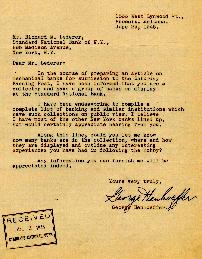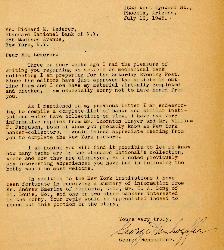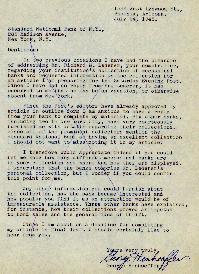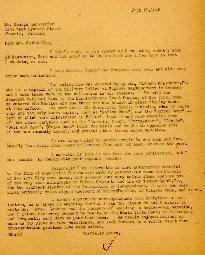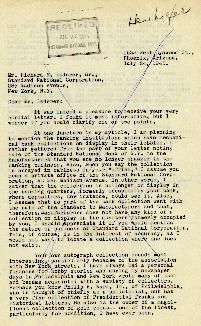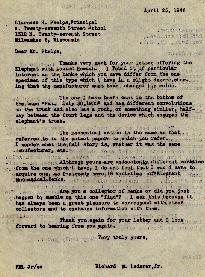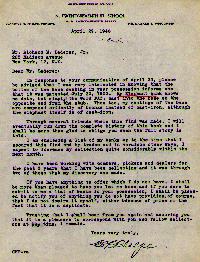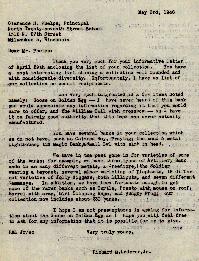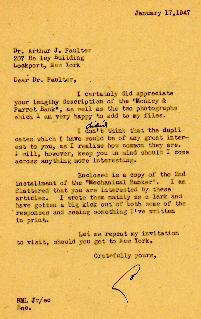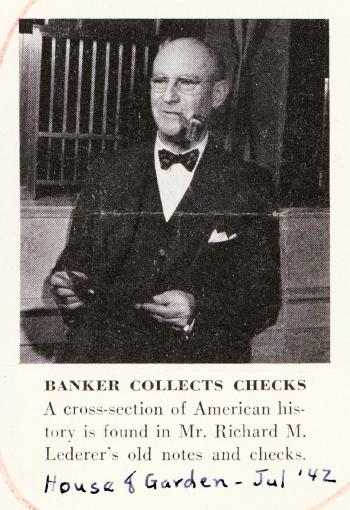|
MECHANICAL BANKS - Manuscripts
- Circa 1940s By RICHARD M. LEDERER, JR. 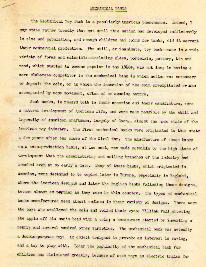 The Mechanical Toy Bank is a peculiarly American phenomenon. Indeed, I may state rather broadly that not until this nation had developed sufficiently in size and population, and enough children had coins for banks, did it warrant their commercial production. The still, or inanimate, toy bank - - made in a wide variety of forms and materials – including glass, porcelain, pottery, tin and wood, which started to become popular in the 1840s, was not long in having a more elaborate competitor in the mechanical bank in which action was necessary to deposit the coin, or in which the insertion of the coin precipitated or was accompanied by some movement, often of an amusing nature. Such banks, in regard both to their creation and their manufacture, were a natural development of American life, and were made possible by the skill and ingenuity of American craftsmen, largely of Conn., almost the home state of the American toy industry. The first mechanical banks were originated in this state a few years after the close of the Civil War. The manufacture of these banks on a mass-production basis, at low cost, was made possible by the high state of development that the manufacturing and selling branches of the industry had reached even at so early a date. Many of these banks, which originated in America, were destined to be copied later in Europe, especially in England, where the American designs and later the English banks following these designs, became almost as popular as they were in this country. The types of mechanical banks manufactured seem almost endless in their variety of designs. There were the boys who swallowed the coin and rolled their eyes; William Tell shooting the apple off his son’s head with a coin; a horse-race started by inserting a penny; and several hundred other varieties. The mechanical bank was actually a double-purpose toy: an object designed to provoke an interest in saving, and a toy to play with. Today the popularity of the mechanical bank for children has diminished greatly, because of such toys as electric trains for play, and public school savings banks to encourage thrift. Although some mechanical banks, made of plastics or white metal, are still manufactured and sold, most of the toy banks produced today are of the still type. Many are distributed by financial institutions to encourage thrift. The mechanical banks are, of course, simply toys, and it is only when they are considered as toys that a proper valuation of their place in the general scene can be had. They were not a special class of merchandise; neither were they produced or sold as objects of art; a position to which some have tried to elevate them, by way of compensating for the fact that they are actually of much later origin than had originally been thought. However, the actual production of the banks - - the molding, finishing, assembling, painting, and other operations - - was manifestly a craft, and the original creation of the bank design or mechanism was quite definitely a form of art; of all the more importance and interest because it was the active, creative kind of real American minor commercial art which transmitted into manufactured products for the use or amusement of the millions. THE J. & E. STEVENS FOUNDRY Unquestionably, the J. & E. Stevens Co., Cromwell, Conn., is the oldest toy manufacturer in the United States; both the original and the most prolific designer and manufacturer of mechanical banks. This, then, is the home of the mechanical bank - - its birthplace and the place where for sixty years more types and larger quantities of such banks were produced than at any other plant. In fact, I may state with reasonable surety that the total production of banks by Stevens, for their own line and on contract for others, exceeded the combined output of other manufacturers. It is not so long since the last mechanical banks of Stevens make were turned out; 1928 marked the end of a long and prosperous era when the charm of the mechanical bank finally gave way to the manufacture of cap pistols, that today make up the normal production of the plant. The company was originally established in 1843 by two brothers, John and Elisha Stevens. It is not true that they founded the company as a toy business. Hardware products, coat and hat hooks, surplice pins, door buttons, shutter screws, axes, tack and shoe hammers, and similar goods were their main products for many years. Nevertheless, some toys and toy parts were made there at very early date. Within ten years of the founding of the plant, miniature sad iron stands and some half a ton of iron wheels for children’s toy wagons were made per week. At this period Stevens employed about forty hands, and did an annual business of $35,000 to $40,000. Early brief accounts of Stevens history which have been published in various articles on banks contain little of value. For the most part, they may all be dismissed as built up on pure conjecture, as there is no one remaining at the plant today who was there before 1890, nor any surviving catalogs or printed material much before that date. No members of the Stevens family have been connected with the company for many years. Starting as a Stevens family affair, it developed into a Frisbie family affair, for, in turn, three generations of the Frisbie family have played an important part in the operation of the company. The Stevens brothers were still living when elder Frisbie entered the company in 1866 as general superintendent, designer, and inventor. Two years later, in 1868, Edward S. Coe, a nephew of the Stevens brothers, also became associated with the firm in the capacity of bookkeeper. He became treasurer in 1872, and finally president in 1898, retaining both positions until 1907. Control of the company was gradually acquired by the Frisbies, and Russell’s son, Charles B. Frisbie, followed Coe as president of Stevens Co.. Coe, who died August 10, 1926, was subsequently connected with local banks and with the Kirby Mfg. Co., toy manufacturers of Middletown. The coming of Russell Frisbie resulted in a marked increase in the firm’s toy manufacturing activities and in their entry into the field as manufacturers in the modern sense. The Stevens Company did not go into the manufacturing of banks on their own until 1872 or 1873, and at the same time were making banks on contract for John Hall, an early bank designer and pattern maker, who designed the earliest bank, known as Hall’s Excelsior Bank. It was not very long before they discontinued making banks on contract for others, as they found it conflicted with the production of their own designs, and competition with their own customers. From a standpoint of the number of designs, and a connection with Stevens during an even more active period of bank production, Charles A. Bailey is without question the most prominent. Bailey was a typical Yankee craftsman. Not only was he an inventor of banks, but also a very skilled pattern and model maker. In fact, he was one of the outstanding figures in the early American toy industry, for he not only designed banks for Stevens (after having manufactured some mechanical banks on his own), but designed and made patterns for countless other toys for both Stevens and other manufacturers, notably bell toys for the Gong Bell Mfg. Co. of East Hampton. Chas A. Bailey was born Sept. 16, 1848 at Cobalt, Conn., where he was raised. Cobalt is one of the towns of Conn. where the American toy industry may really be said to have been born. Bailey had a small shop in the back of his home in Cobalt. Where he learned his trade is not known. The shop in Cobalt was his source of income, and in it he pursued his trade from around 1875 to 1882, including a great deal of pattern making and designing of toys. Though he was free lancing and was a bank manufacturer on his own, he soon was making patterns for casting banks in iron for Stevens. Russell Frisbie considered Bailey an ideal man for banks, and from his shop came many unique and interesting designs. Bailey married in 1880, and several years later moved to Middletown, where he opened a pattern shop on Main Street. This shop he maintained until 1889 or 1890. Then he yielded to the offers of Frisbie and went to work at Stevens, where he designed many banks and continued until 1916 as their ace pattern maker and bank designer. MECHANICAL TOY BANKS 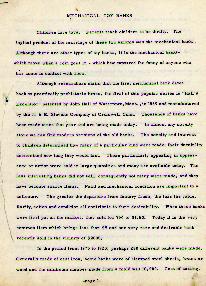 Children love toys. Parents teach children to be thrifty. The logical product of the marriage of these two axioms was the mechanical bank. Although there are other types of toy banks, it is the mechanical banks – which move when a coin goes in – which have captured the fancy of anyone who has come in contact with them. “Gimmie penny, Uncle Joe, see the horsy jump” and even Uncle Joe would fish out his hard earned coin to feed nephews omnivorous “Trick Pony” bank. Mechanical banks hold a fascination for young and old, and although originally designed to promote thrift for the youngsters, they have today become important collectors’ items. They were childrens toys 80 to 25 years ago and rarely cost more than a dollar. Uncle Joe’s penny not only amused the child and taught him thrift, but today carries on to motivate a great hobby. Although researchers claim that the first mechanical bank dates back to practically prehistoric times, the first of this popular series is “Hall’s Excelsior” patented by John Hall of Watertown, Mass., in 1869 and manufactured by the J. & E. Stevens Company of Cromwell, Conn. Thousands of banks have been made since that year and are being made today. In almost any novelty store we can find modern versions of the old banks. The novelty and interest to children determined how many of a particular kind were made; their durability determined how long they would last. These particularly appealing in appearance or action were sold in large quantities and many are available today. The less interesting banks did not sell, consequently not many were made, and they have become scarce items. Paint and mechanical condition are important to a collector. The greater the departure from factory fresh, the less the value. Rarity, action and condition all contribute to their desirability. When these banks were first put on the market, they sold for 75¢ to $1.50. Today it is the very common item which brings less than $5 and one very rare and desirable bank recently sold in the vicinity of $2000. In the period from 1870 to 1920, perhaps 280 different banks were made. Generally made of cast iron, some banks were of stamped steel sheets, brass or wood and the minimum number made from a mold was 10,000. Cost of casting, finishing, assembling and hand-painting have made the old mechanical bank a thing of the past. One could not produce such an item today at a price which would be marketable. Those currently being manufactured are made of “tin” or plastic, and although they are clever, they really do not compare with the old design or workmanship. Principal producers of banks were the iron founders; Manufacturers of stoves, irons, toys, etc. In this field, the outstanding names were Stevens, Shepard Hardware of Buffalo, Kyser & Rex of Philadelphia, Judd Co. of Wallingford, Connecticut and Hubley of Lancaster, Pa. The latter company is still making banks and toys. Prominent jobbers engaged in the distribution of banks were Selchow and Righter, L. H. Mace & Co. and Conway Bros. I feel that the most mechanically ingenious and complex of all the banks is the Girl Skipping Rope. To permit the coin to be inserted, a lever is depressed and the figure of a girl goes through the motions of jumping rope, moving her head from side to side and her feet back and forth. It took James H. Bowen about 2000 words and two pictures to describe it to the U.S. Patent Office, but I need not be that explicit! The bank is “set” by a crank, and pushing a lever permits a strong spring to spin a fly-wheel. The bow-shaped rope is attached to a wheel which gets its motion by friction from the fly-wheel. As the point where the hands are fastened is different from that where the rope is attached, the girl moves up and down as the rope spins. The legs are fastened by a crank-shaft arrangement and the head by a kicking device to the shaft through the hands. When set in motion, this bank gives a most realistic representation of the subject. Perhaps the simplest yet cleverest in design is the Boy on Trapeze. This bank shows a boy, his foot attached to a ball, straddling a horizontal bar. When a coin is placed in a slot in his cap, the weight of the coin causes the boy to rotate on the bar. A penny turns him once, a nickel makes him spin twice, and a quarter three times. (Some day I want to try it with a $20 gold piece!) Perfect balance! The result of considerable experimentation and careful workmanship. Around March fifteenth, Uncle Sam dropping coins into his carpet bag is always good for a laugh. A sure collector of coins of the curious is a rifleman who shoots money into a slotted tree stump. Then, there’s a dentist pulling a reluctant patient’s tooth. Place a coin in the dentist’s pocket. Then press a button. Out comes the tooth while the dentist falls one way, the patient topples over backward in his chair and the coin drops into a slot. Not all banks are mechanical, there are four general types - - mechanical, semi-mechanical, registering and “stills”. Registering banks show the amount of money deposited; “stills” simply hold money. “Professor Pug Frog’s Great Bicycle Feat” is a typical bank. Guided by an involved series of springs and release levers, Proferssor Pug Frog pivots and drops a coin into a slot. So simple it never caught the fancy of the general public and now a rarity is the “Barrel with Arms”. You push the arms down to let a coin drop into the barrel. A bank passed through many steps before it was finally sold to some doting parent for the education and pleasure of his child. The designer first made a solid model in specially prepared wax. From this a plaster of paris mold in two halves was taken. Then wax hollow models are made. The next step is to separate from the complete model the parts which are to be movable and fashion a fresh model in wax of each part with an end or joint attached. From the completed wax working model a brass working model is founded. This model is smoothed, perfected and then sent to the iron foundry where the finished banks are produced. The manufacturers then painted and boxed the banks and sold them to jobbers for distribution to retailers, where they might be purchased by the public. My collection has been loaned many times to institutions for displays, to charities for fund raising and to clubs for hobby shows. This pleasure that the banks give to others added to those inherent in any collecting; enjoyment of ownership, accumulation of knowledge and the friendships with other collectors, make collecting old mechanical banks a hobby which cannot be surpassed. |
TRANSCRIPT OF MR. LEDERER AS GUEST SPEAKER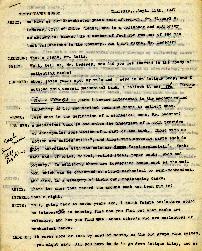 WESTCHESTER GUEST Thursday… Sept. 11th, 1947 SEITZ: We have as our Westchester Guest this afternoon, Mr. Richard M. Lederer, Jr., of White Plains, who is a collector and authority on mechanical banks. As a matter of fact you own one of the ten best collections in the country… am I not right, Mr. Lederer? LEDERER: That’s right, Mr. Seitz. SEITZ: Well, tell us, Mr. Lederer, how did you get started in the hobby of collecting banks? LEDERER: About seven years ago, my wife and I were in an Antique Shop, and I noticed this unusual mechanical bank, I believe it was the Two Bull Frogs, and I became interested in the mechanism and ingenuity of it, and decided then and there to collect them. SEITZ: Just what is the definition of a mechanical bank, Mr. Lederer? LEDERER: A mechanical bank is one which the insertion of a coin provides or accompanies some motion of a part of the bank. Those with no motion are called “stills”, and those with moveable parts that do not coordinate with the coin are “semi-mechanical”. Banks were made of brass, nickel, rolled steel, paper mache, wood and pottery. In addition, there are borderline banks such as the mail box, which can be construed as either mechanical or semi-mechanical. And also, in a category of their own, registering banks. SEITZ: They are the ones that record the amount that has been put in? LEDERER: That’s right. SEITZ: Well, going back to seven years ago, I think future collectors would be interested in knowing just how you find out what banks are valuable, and how you find out about others who are collectors of mechanical banks. LEDERER: It works more or less by word of mouth, or the old grape vine system, you might say. All you have to do is go down Antique Alley, and as your chatting with the dealer about banks and such, he’ll probably say to you. “Say do you know so and so?”. “Now he has a wonderful collection of mechanical banks, and I’m sure you’ll enjoy seeing his collection”? You get his address and look him up. I’ve met a lot of wonderful people through my collecting banks and have struck up quite a correspondence with different bank collectors throughout the country. I’ve obtained my banks by advertising, poking through junk and antique shops, and peering into dark cobwebbed corners of my friends attics. (You can obtain a great deal of valuable information from the patents of banks, and all you have to do to acquire these is to write to the Patent Office in Washington.) SEITZ: What about the history of the mechanical banks, how far back do they date? LEDERER: Well, relatively little has been written on the subject of mechanical banks. The Metropolitan Museum of Art, records the first one as being made in China during the Han Dynasty around the beginning of the Christian Era. Then writers on Archimedes claim that he made some but jumping back to more modern times, the first of this popular series, according to my records, is “Hall’s Excelsior” patented by John Hall of Watertown, Massachusetts in 1899. SEITZ: I know that you have some 240 varied coin banks in your collection, and that it would be impossible to describe even half of them in the time allotted, but could you give us a description of some of the outstanding ones that you have? LEDERER: I’d be glad to Mr. Seitz. My favorite mechanical bank is the Girl Skipping rope, and I feel that this is the most mechanically ingenious and complex of all banks. To permit the coin to be inserted a lever is depressed and the figure of a girl goes through the motions of jumping rope, moving her head from side to side and her feet back and forth. How James H. Bowen of Philadelphia was able to design such an intricate mechanism will always be a mystery to me. It took 2,000 words and two pictures to describe it to the United States Patent Office. SEITZ: That is a lot of words. What about some of the others Mr. Lederer? LEDERER: Well, then, There’s the Dentist pulling a patient’s tooth. You place a coin in the dentist’s pocket, then press a button. Out comes the tooth while the dentist falls one way, the patient topples over backward in his chair and the coin drops in the slot. Then there’s a bank, Creedmore, where a rifleman shoots money into a slotted tree stump. The “Boy on Trapeze” bank is quite clever. After a coin is put in a slot in his cap, the boy rotates on a bar. A penny turns him once, a nickel twice, a quarter three times and a 50-cent piece six times. SEITZ: Say, strictly between us, what is your average haul when you show how these banks work to curious friends? LEDERER: That idea occurred to me, but I unfortunately use my own coins. (Edit in pen “I was able to send $5- to the 100 Neediest cases last year and I think I’ll be able to send more this year.”) SEITZ: Well, at least it’s a hobby that may become useful some day. (Edit in pen “Well, I see you’ve turned your hobby into a worthy cause too.). Getting back to collecting, how does one determine the value of these banks? LEDERER: The value of the bank is affected by its paint and mechanical condition as well as its rarity. The greater the departure from factory fresh, the less the value. SEITZ: Well, tell me Mr. Lederer, does your wife go with you when you are hunting for a rare mechanical bank? LEDERER: In the beginning we used to have great times looking through various shops for banks, but lately she has sort of lost interest. You see we have a five year old daughter that keeps her rather busy, and now since I’ve been collecting banks for seven years they are brought to my attention, and I don’t have to go looking for them. It was quite a bit more fun in the beginning. I’m now starting on a new hobby of making miniature reproductions of furniture. SEITZ: That should prove an interesting hobby too. Well, thank you for being here this afternoon, Mr. Lederer and telling us about your mechanical banks, it certainly has been most interesting. |
|
LEDERER CORRESPONDENCE (transcribed)
1533 West Lynwood St.,
1533 West Lynwood St.,
1533 West Lynwood St.,
July 20, 1945
1533 West Lynwood St., |
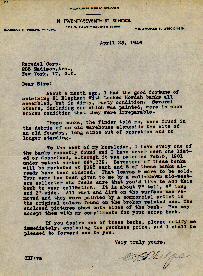 MILWAUKEE PUBLIC SCHOOLS N. TWENTY-SEVENTH ST. SCHOOL 1312 N. TWENTY-SEVENTH STREET MILWAUKEE 5, WISCONSIN CLARENCE H. PHELPS, PRINCIPAL April 23, 1946 Reredel Corp. 285 Madison Ave., New York, 17, N.Y. Dear Sirs: About a month ago, I had the good fortune of obtaining 21 Elephant With Locked Howdah banks all assembled, but in dirty, rusty condition. Several others, including one which was painted, were in such broken condition that they were irreparable. These banks, the finder told me, were found in the debris of an old warehouse alongside the site of an old foundry, long since out of operation and no longer standing. To the best of my knowledge, I have every one of the banks recently found and I have never seen one listed or described, although it was patented Feb. 5, 1901 under patent number 667,332. Seventeen of these banks will be marketed at $125 each and 8 of these banks already have been ordered. That leaves 9 more to be sold. Your name has been given to me by a well-known mid-western collector who feels sure that you’d like to add this bank to your collection. It is about 7" tall, 6" long and 3" wide. All rust and dirt on the surface was removed and they were painted by a commercial artist in the original colors found on the broken painted one. The enclosed pictures show both sides of the bank. You may accept them with my compliments for your scrap book. If you desire one of these banks, please notify me immediately, enclosing the purchase price, and I shall be pleased to forward to you. Very truly yours, CHP:va Clarence H. Phelps (signed)
April 25,
1946
MILWAUKEE
PUBLIC SCHOOLS
May 3rd,
1946 |
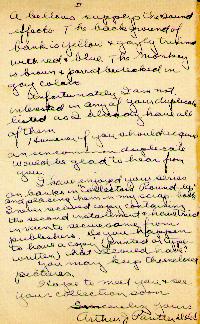 207 Beverly Bldg. Lockport , N.Y. Dec. 28, 1946 Dear Mr. Lederer, Appreciated your very cordial letter and intended to write sooner but thought two pictures of the Monkey & Parrot bank would be interesting. The developing & printing did postpone my letter somewhat. This bank is quite colorful, its action being quick & ingenious. It is #229 on Sherwood’s list and is German made of tin. It measures 1-1/2" x 6" x 1-1/2". The lever on the left is depressed after coin placed on the monkey’s tail, which causes coin to roll onto monkey’s paws as the lever is released the coin shoots upward into the parrot’s mouth. A bellows supplies the sound effects. The background of bank is yellow & gaily trimmed with red & blue. The monkey is brown & parrot bedecked in gay colors. Unfortunately I am not interested in any of your duplicates listed as I already have all of them. However if you should acquire an uncommon duplicate would be glad to hear from you. I have enjoyed your series on banks in “Collector’s Round-Up” and placing them in my scrap-book. I never received copy containing the second installment & have tried in vain to secure same from publishers. Do you happen to have a copy (printed or type-written) that I could have? You may keep the enclosed pictures. I hope to meet you & see your collection soon. Sincerely yours, Arthur J. Paulter, DDS
January 17,
1947 Also see:
|

